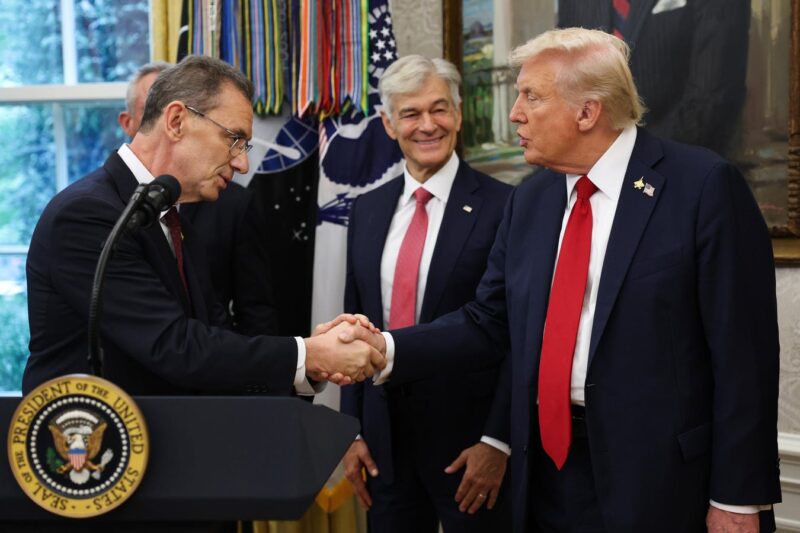President Donald Trump shakes hands with Pfizer CEO Albert Bourla as he announces a deal to lower prescription drug prices in the Oval Office of the White House on September 30, 2025 in Washington, DC. The Trump administration has reached an agreement with Pfizer to sell its medications to Medicaid at lower prices as well as to patients on a website called TrumpRx. (Photo by Win McNamee/Getty Images)
Getty Images
The Trump administration has reached an agreement with the drug company Pfizer to sell almost all of its medications to Medicaid at “most favored nation” prices, and to offer for sale some of its drugs at lower prices on a federal government website called TrumpRx. But there are more unknowns regarding the initiative than things we do know. The missing details make it very difficult to evaluate the impact on patients as well as Medicaid.
What We Know
The TrumpRx website is due to launch in 2026. The government platform will serve as a virtual marketplace where pharmaceutical companies can make their products available at discount prices. Pfizer has said it will be selling some of its drugs on the platform. The company disclosed examples, including an eczema treatment called Eucrisa, Duavee for menopause symptoms, Toviaz for overactive bladder and the autoimmune drugs Abrilada and Xeljanz. Pfizer says these medications will “often” be provided at the most favored nation price, and “and always at lower prices than currently available.” For uninsured patients and perhaps some underinsured individuals, this will be meaningful.
The Wall Street Journal reported that most favored nation prices will be based on prices paid in other similarly wealthy countries, which include Canada, France, Germany, Italy, Japan, the United Kingdom, Switzerland and Denmark.
Pfizer will sell most of its medications to Medicaid at most favored nation prices. Medicaid is the state-federal government program in the United States that provides health insurance for adults and children with limited income and resources. Presumably, the discounts already announced for a handful of treatments will serve as a benchmark for negotiating supplemental rebates in Medicaid. Typically, drug manufacturers and states can voluntarily negotiate supplemental rebates in exchange for preferred status with respect to patient access to medicines. Such rebates are in addition to federally mandated discounts.
What’s Unknown
When Trump announced the deal reached with Pfizer, the administration affirmed that terms of the agreement were confidential. It’s expected that more announcements will be made in the near future regarding deals struck with other drug makers. In all probability, these will be confidential, too.
Confidentiality is standard practice. However, in light of Trump’s repeated statements claiming he would lower prescription drug prices in the U.S. “almost immediately by 30% to 80%,” shedding light on what this means for patients is essential.
There’s a lot we don’t know. For example, regarding TrumpRx it’s unknown which drug manufacturers will participate, which medications will be available and at what price.
Presumably, the announced discount percentages are calculated based on a list price. But which one? There are several. And how do publicly revealed discount levels compare to existing rebate percentages in, say, the Medicaid market? Keep in mind, payers in the commercial, Medicare and Medicaid markets don’t pay list prices for drugs. Pharmaceuticals in highly competitive therapeutic classes have rebates as high as 80% off of list prices, which they negotiate with insurers and pharmacy benefit managers.
Pfizer says that the price of Eucrisa will be discounted by 80% on TrumpRx. While this applies to patients making purchases on the website, it could serve as a starting point for negotiations of supplemental rebates in Medicaid. Is the 80% number similar to the current rebate levels for Eucrisa?
What are the implications of TrumpRx for people with commercial or Medicare insurance? The only thing we can state with relative certainty is that with the exception of uninsured Americans, the policy will have little or no impact on the level of out-of-pocket pharmaceutical expenses paid by most patients. But perhaps for some underinsured patients with commercial or Medicare coverage, TrumpRx could help reduce their financial burden. Here, it’s important to know though whether purchases made on TrumpRx will count towards their deductible. This is the amount patients must spend on pharmaceuticals before coverage kicks in.
An informed guess suggests TrumpRx purchases won’t apply towards a person’s deductible. in which case the portal loses a lot of its value. By not reducing a patient’s deductible amount, patients will have to pay full freight for other drugs prescribed to them until they reach the coverage threshold level.
Then there’s the issue of the most favored nation price itself. Senator Ruben Gallego (D-Arizona) asked what data would be used to make Pfizer’s most favored nation formula and by extension, other companies that agree to deals with the administration. In other words, how is the most favored nation price calculated?
In this context, policymakers need to know whether the most favored price is based on a foreign list or net price. Most countries don’t publicly disclose net prices. Are they being encouraged or incentivized to do so by the administration? Furthermore, are weighted averages involved, accounting for differences in utilization between countries? This is vital, as any meaningful price calculation must incorporate such differences. And, what happens when a drug is approved in the U.S. but not in one or more or any of the other comparator counties? How do prices get calculated under these circumstances?
This may also be relevant with respect to any possible demonstration projects the administration is planning for physician-administered and outpatient drugs in Medicare, the government insurance program for the elderly and disabled persons. It’s been hinted that the Center for Medicare and Medicaid Innovation may soon propose testing novel payment methods based on a most favored nation model.
Finally, some pharmaceutical firms that could sign on as participants in TrumpRx may already have direct-to-consumer platforms. Will TrumpRx supplant these, or will they coexist? if so, how?
The Trump administration has called its initiative an “historic” step in drug pricing policy. But the lack of critical details makes it hard to properly evaluate the impact on patients and Medicaid payers.









